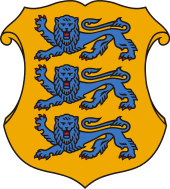Prime Minister of Estonia
The Prime Minister of Estonia (Estonian: peaminister, literally Main Minister or Head Minister) is the head of government of the Republic of Estonia. The prime minister is nominated by the President after appropriate consultations with the parliamentary factions and confirmed by the Parliament. In case of disagreement, the Parliament can reject the President's nomination and choose their own candidate. In practice, since the Prime Minister must maintain the confidence of Parliament in order to remain in office, he is usually the leader of the senior partner in the governing coalition. The current Prime Minister is Jüri Ratas of the Centre Party. He took the office on 23 November 2016.
| Prime Minister of the Republic of Estonia
Eesti Vabariigi peaminister | |
|---|---|
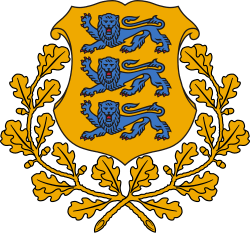 Coat of Arms of Estonia | |
| Member of | European Council |
| Residence | Stenbock House, Tallinn |
| Appointer | President of Estonia |
| Term length | General elections to the Riigikogu are held every four years at most. The Prime Minister is by convention the leader of the victorious party. No term limits are imposed on the office. |
| Inaugural holder | Konstantin Päts |
| Formation | 24 February 1918 |
| Salary | €5,288 monthly[1] |
| Website | http://valitsus.ee/ |
 |
|---|
| This article is part of a series on the politics and government of Estonia |
|
In his role as appointed by the President and laid forth in the Constitution, the Prime Minister serves as the head of government. He does not head any specific ministry, but is, in accordance with the constitution, the supervisor of the work of the government. The Prime Minister’s significance and role in the government and his relations with other ministries often depend on the position of the party led by the prime minister in vis-à-vis the coalition partners, and on how much influence the prime minister possesses within his own party. If the prime minister has a strong position within his party, and the government is made up solely of representatives of that party, he can enjoy considerable authority. In all crucial national questions, however, the final word rests with Riigikogu as the legislative power.
Unlike his counterparts in other parliamentary republics, the Prime Minister is both de jure and de facto chief executive. This is because the Constitution explicitly vests executive power in the Government, of which the Prime Minister is the leader. In most other parliamentary republics, the president is at least nominal chief executive, while bound by convention to act on the cabinet's advice.
History
Estonia was governed by a Prime Minister during the first two years (1918–1920) of its independence after the collapse of the Russian Empire.
Under Estonia's 1920 constitution, the head of government was called the State Elder (riigivanem), who was also head of state. This system was a radically parliamentary system because the State Elder could be dismissed by the Parliament with a simple majority. Moreover, the State Elder was not the commander-in-chief of the armed forces, nor could he ratify laws or dissolve Parliament. The dissolution of Parliament was only possible through a referendum [2]. Under a new constitution passed by plebiscite in 1933, the position of Prime Minister was recreated as head of government in 1934 in a more presidential system. Under this constitution, the President could appoint and dismiss the Prime Minister and Cabinet, veto laws, give decrees (statutes) and dissolve Parliament [3]. The sitting State Elder, Konstantin Päts, appointed himself to the position of Prime Minister and in this position was then able to suspend elections for Elder of State and for the Estonian Parliament. He remained Prime Minister, declaring himself "President-Regent", until 1938, when elections were held under a new constitution and he was elected President.
1918–1920
| Portrait | Name | Term of Office | Political Party | Cabinet | Riigikogu (Election) |
Separate Head of State | |||
|---|---|---|---|---|---|---|---|---|---|
| Took Office | Left Office | Days | |||||||
| The executive order of the Provisional Government and the Council of Elders of the Provincial Assembly replaced the office of Chairman of the Council of Ministers. | |||||||||
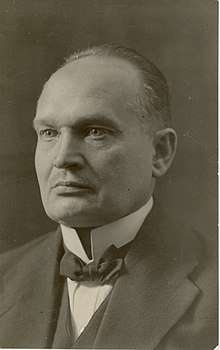 |
Konstantin Päts Prime Minister of the Provisional Government |
12 November 1918 | 9 May 1919 | 179 | Country People's Union (EMRL) |
Päts I Provisional EMRL–ETE–EDE–ESDTP |
Provincial Assembly (1917) |
None | |
| Päts III Provisional EMRL–ETE–EDE–ESDTP EMRL–ETE–EDE–ESDTP–SEE EMRL–ETE–EDE–ESDTP–SEE–VKK EMRL–ETE–ER–ESDTP–SEE–VKK EMRL–ETE–ER–ESRP–SEE–VKK | |||||||||
| Otto August Strandman (1875–1941) 1st Prime Minister |
9 May 1919 | 18 November 1919 | 194 | Labour Party (ETE) |
Strandman I ETE–ESDTP–ER |
Constituent Assembly (1919) | |||
 |
Jaan Tõnisson (1868–1941?) 2nd Prime Minister |
18 November 1919 | 28 July 1920 | 254 | People's Party (ER) |
Tõnisson I ER–ETE–ESDTP | |||
 |
Ado Birk (1883–1942) 3rd Prime Minister |
28 July 1920 | 30 July 1920 | 3 | People's Party (ER) |
Birk ER–ETE–KRE | |||
 |
Jaan Tõnisson (1868–1941?) 4th Prime Minister (2nd term) |
30 July 1920 | 26 October 1920 | 89 | People's Party (ER) |
Tõnisson II ER | |||
 |
Ants Piip (1884–1942) 5th Prime Minister |
26 October 1920 | 20 December 1920 | 56 | Labour Party (ETE) |
Piip ETE | |||
| The 1920 Constitution replaced the office with State Elder. | |||||||||
1934–1937
| Portrait | Name | Term of Office | Political Party | Cabinet | Riigikogu (Election) |
Separate Head of State | |||
|---|---|---|---|---|---|---|---|---|---|
| Took Office | Left Office | Days | |||||||
| The 1934 Constitution divided the office of State Elder between a new office called State Elder and a Prime Minister. | |||||||||
 |
Konstantin Päts 6th Prime Minister (in duties of the State Elder) (2nd term) |
24 January 1934 | 3 September 1937 | 1,319 | Farmers' Assemblies and Association of Settlers (PK/ARVK) |
Päts V non-party coalition |
V (1932) |
Prime Minister in duties of the State Elder Konstantin Päts | |
| Fatherland Union (I) [Note 1] |
Parliament disbanded [Note 2] | ||||||||
| The Amendment Act of the 1938 Constitution temporarily merged the offices of State Elder and Prime Minister into President-Regent. | |||||||||
1938–1944
| Portrait | Name | Term of Office | Political Party | Cabinet | Riigikogu (Election) |
Separate Head of State | |||
|---|---|---|---|---|---|---|---|---|---|
| Took Office | Left Office | Days | |||||||
| The 1938 Constitution divided the office of President-Regent between a President and a Prime Minister. | |||||||||
 |
Kaarel Eenpalu (1888–1942) Acting Prime Minister |
24 April 1938 | 9 May 1938 | 537 | Fatherland Union (I) |
Päts V non-party coalition [Note 3] |
Parliament disbanded |
President Konstantin Päts (1938-1940) | |
| 7th Prime Minister | 9 May 1938 | 12 October 1939 | Eenpalu II non-party coalition |
VI (1938) | |||||
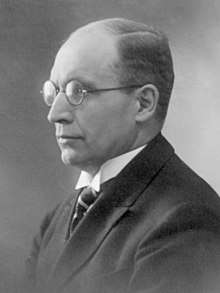 |
Jüri Uluots (1890–1945) 8th Prime Minister |
12 October 1939 | 21 June 1940 | 254 | Fatherland Union (I) |
Uluots non-party coalition | |||
| 1st Soviet Occupation | |||||||||
| German Occupation | |||||||||
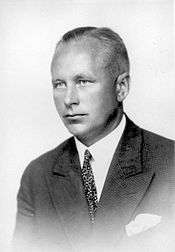 |
Otto Tief (1889–1976) Acting Prime Minister |
18 September 1944 | 25 September 1944 | 8 | None | Tief non-party coalition |
Parliament disbanded |
Prime Minister in duties of the President Jüri Uluots | |
| 2nd Soviet Occupation (See Estonian Government in Exile) | |||||||||
1990–present
| Portrait | Name | Term of Office | Political Party | Cabinet | Riigikogu (Election) |
Separate Head of State | |||
|---|---|---|---|---|---|---|---|---|---|
| Took Office | Left Office | Days | |||||||
| 2nd Soviet Occupation (See Estonian Government in Exile) | |||||||||
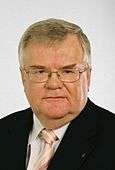 |
Edgar Savisaar (1950– ) 1st Prime Minister of the Interim Government |
3 April 1990 [Note 4] |
29 January 1992 | 668 | Popular Front (RR) |
Savisaar Interim various coalition partners |
Supreme Council (1990) [Note 5] |
Chairman of the Supreme Council Arnold Rüütel | |
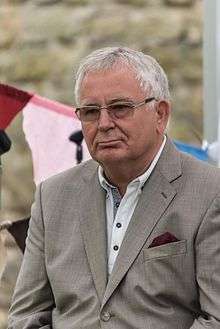 |
Tiit Vähi (1947– ) 2nd Prime Minister of the Interim Government |
29 January 1992 | 21 October 1992 | 266 | None | Vähi Interim various coalition partners | |||
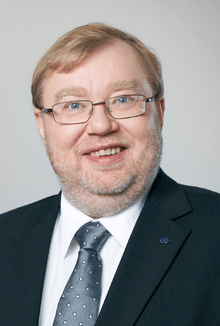 |
Mart Laar (1960– ) 9th Prime Minister |
21 October 1992 | 8 November 1994 | 749 | Fatherland (I) |
Laar I I–M–ERSP I–M–ERSP–L |
VII (1992) |
President Lennart Georg Meri (1991-2001) | |
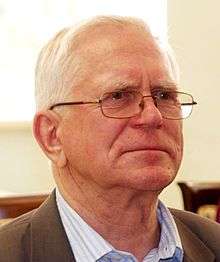 |
Andres Tarand (1940– ) 10th Prime Minister |
8 November 1994 | 17 April 1995 | 161 | Moderates (M) |
Tarand M–I–ERSP–L–P | |||
 |
Tiit Vähi (1947– ) 11th Prime Minister (2nd term) |
17 April 1995 | 17 March 1997 | 701 | Coalition Party's and Country People's Alliance (KMÜ) |
Vähi I KMÜ–K |
VIII (1995) | ||
| Vähi II KMÜ–ER KMÜ–AP | |||||||||
| Mart Siimann (1946– ) 12th Prime Minister |
17 March 1997 | 25 March 1999 | 739 | Coalition Party's and Country People's Alliance (KMÜ) |
Siimann KMÜ–AP | ||||
 |
Mart Laar (1960– ) 13th Prime Minister (2nd term) |
25 March 1999 | 28 January 2002 | 1,041 | Pro Patria Union (IL) |
Laar II IL–RM–RE |
IX (1999) | ||
| President Arnold Rüütel (2001-2006) | |||||||||
| Siim Kallas (1948– ) 14th Prime Minister |
28 January 2002 | 10 April 2003 | 438 | Reform Party (ER) |
Kallas ER–K | ||||
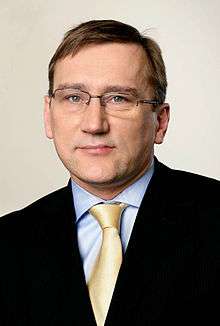 |
Juhan Parts (1966– ) 15th Prime Minister |
10 April 2003 | 12 April 2005 | 735 | Res Publica Party (RP) |
Parts RP–ER–ERL |
X (2003) | ||
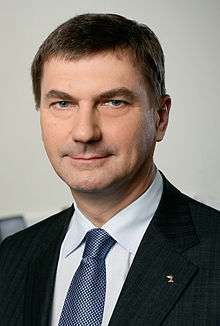 |
Andrus Ansip (1956– ) 16th Prime Minister |
12 April 2005 | 26 March 2014 | 3,271 | Reform Party (ER) |
Ansip I ER–K–ERL | |||
| President Toomas Hendrik Ilves (2006-2016) | |||||||||
| Ansip II ER–IRL–SDE ER–IRL |
XI (2007) | ||||||||
| Ansip III ER–IRL |
XII (2011) | ||||||||
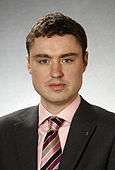 |
Taavi Rõivas (1979– ) 17th Prime Minister |
26 March 2014 | 23 November 2016 | 973 | Reform Party (ER) |
Rõivas I ER–SDE | |||
| Rõivas II ER–SDE–IRL |
XIII (2015) | ||||||||
| President Kersti Kaljulaid (2016-) | |||||||||
 |
Jüri Ratas (1978– ) 18th Prime Minister |
23 November 2016 | Incumbent | 1362 | Centre Party (K) |
Ratas K–SDE–IRL | |||
| Ratas II K–EKRE–I |
XIV (2019) | ||||||||
References
- "Riigikogu liikmete ja teiste kõrgemate riigiteenijate palk ei muutu". Postimees. 15 March 2017.
- (Seppo Zetterberg, "A History of Estonia" / Viron historia. 3rd edition. Helsinki: The Finnish Literary Society / Suomalaisen Kirjallisuuden Seura, 2007, pages 524–525)
- (Zetterberg 2007, pages 558–559)
Notes
- All political parties were banned on 20 March 1935. The Fatherland Union was the only sanctioned political organization, but cannot be considered a political party per se.
- The "Era of Silence" began on with Päts' self-coup on 21 March 1934. The Riigikogu approved of the coup retroactively on 15 March 1934. The Riigikogu was thereafter not convened after 2 October 1934. It was officially disbanded on 1 October 1938.
- Although Konstantin Päts resigned as President-Regent on 24 April 1938 to become the President on the same day, his cabinet remained temporarily in office until 9 May 1938, headed by acting Prime Minister Kaarel Eenpalu.
- The Supreme Council of the Estonian SSR on 30 March 1990 declared Soviet rule to have been illegal since 1940 and declared a transition period for full independence. Full independence was restored on 20 August 1991.
- Elections were for the "Supreme Soviet", but the translation of the assembly name was changed before the Interim Government was sworn in, on 29 March 1990.
